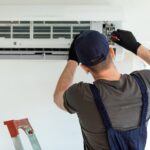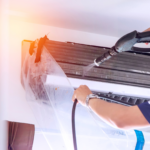Summer’s almost here, and the hot weather has begun to kick in already. After surviving a few days of sweltering heat – and knowing that there’s plenty more on the way – you may be considering investing in a cooling system for your house.
You may have heard of evaporative cooling as a way to cool the air in your house with a cheaper installation cost and running cost than a conventional air conditioner.
Here, we look at the effectiveness of evaporative coolers in comparison to air conditioners, how much they cost and help you decide which is the best option for you.
What is an evaporative cooler and how does it work?
An evaporative cooling system harnesses evaporation and its cooling effect to lower the air temperature in your home.
An evaporative cooler is composed of the following key components:
– fan
– thick water absorbent pad
– water supply;
– some simple controls.
The pads are thick and have many layers to increase their surface area. The pads are soaked in water. The fan then draws air from outside your house across the pad. As water evaporates from the pad, there is a temperature drop – often by as much as 20 degrees. This cooled air is then drawn into the house and released for supply into grilles scattered throughout the house.
Pro’s and Con’s of Evaporative coolers
Humidity in your home
An evaporative cooler leaves the air with more humidity in it after the air has been cooled than before.
In high-humidity environments, the added humidity may lead to mould growth.
Generally, in tropical and sub-tropical environments, particularly in coastal environments, on of the considerations with Air Conditioning is to reduce the amount of humidity in the air, not increase it. As humidity increase so does the apparent heat – how you feel on a 30-degree day is wildly different in 40% humidity vs 60% humidity.
Cooling Effectiveness in High Humidity
Evaporative coolers can be very effective on hot days – provided they are dry, hot days. Evaporative cooling only works when there is evaporation. The higher the moisture content in the air, the less evaporation occurs.
In general terms, evaporative coolers work very well when outdoor air relative humidity is less than 30%, they work reasonably well with humidity between 30 and 50%, and above 50% humidity, they do not work well at all. In high-humidity environments, a traditional refrigeration-style air conditioner is recommended.
Lower running costs
Evaporative coolers have very low running costs when compared to ducted air conditioning for the same space. This is because they rely on evaporation to do the cooling – the only inputs into this process that cost money are – the water and the electricity to run the fan. The cooling itself is free- in the form of evaporation.
An evaporative cooler may cost around 20c per hour to run vs a traditional ducted air conditioning system which could be as much as $2 per hour – depending on its size and efficiency.
Low noise
If noise is a concern, then evaporative cooling wins hands down over traditional air conditioners.
The only noise that an evaporative cooler makes is from its fan – which in itself is not terribly noisy. Typically evaporative coolers are mounted on your roof, whilst traditional air conditioning systems are ground mounted so that limited noise is further away from you and mostly dissipated in the air above your house.
Heating vs cooling
Almost every refrigerant-based air conditioner sold on the market today has reverse cycle capability – meaning it can both heat and cool as the season dictates.
Evaporative coolers can only cool – so if you need heating as well as cooling – you will need to install stand-alone heating to complement your evaporative cooler.
How much does an evaporative cooling cost to buy and maintain?
One of the biggest advantages of evaporative cooling is its cost. Evaporative air conditioners are very economical – to run, install and buy.
The cost of buying and installing an evaporative cooler to cool your house would normally be in the $3,000 – $6,000 range, depending on the size of your house.
Evaporative coolers should be regularly maintained, just like refrigerant-based air conditioning. If not maintained, their effectiveness will be reduced, and you may have unwanted odours and health risks.
What is a refrigerant-based air conditioner?
An air conditioner is a unit that cools down an area by drawing out the hot or humid air and pushing it through a coil that is cooled with refrigerant. As the air is passed over the coil, the air reduces in temperature and humidity is removed from the air. There are quite a few different types of air conditioners available, each of these work differently and have different methods of installation. Below, we briefly touch on some of the most popular types of air conditioning available.
Split system air conditioner
As its name implies, a split system air conditioner has two separate parts; an outdoor unit and an indoor unit. The indoor component, mounted on the wall, houses the evaporator and fan. The outdoor unit, which is usually hidden somewhere outside, has a compressor. The two components are connected via electric wire and pipes.
The evaporator fan in the indoor unit pulls warm air out of a room or space and passes it through a tube filled with refrigerant. The outdoor unit cools the refrigerant and then sends it back to the evaporator to continue the cooling cycle.
Ducted air conditioners
Ducted air conditioners have more capacity and are commonly used to cool a whole house or a large space. They have ductwork through the roof and walls of an area, the evaporator is usually located in the house’s roof space and the compressor is usually located outside the house or space. It works in a similar way to a split system, in the sense that warm air is sent outside to be cool and then pushed back into the room.
Portable air conditioners
Portable air conditioners are reasonably cheap to buy and are a popular choice to cool a small area. It is a single unit that works by using a single exhaust hose that funnels warm air out of the room, and the refrigerant system inside the unit cools air and then sends it back into the room.
How much does an air conditioner cost to buy, install and run?
The price of an air conditioning unit will depend on the type of system you’re using. Portable air conditioners start from around $300, split system air conditioners start from around $650, and central air conditioners start from around $4000 (please check the price for the central ac unit).
The installation costs of an air conditioner will significantly depend on the type of system you choose to install. Portable air conditioners are so easy to install that you can probably do it yourself.
On the other hand, split system air conditioning and central air conditioning will require the help of a technician. Both systems use electrical wires, and central air conditioners require extensive ductwork to be installed through the ceilings and in cramped places.
You can generally expect a split system air conditioner to take about four to eight hours. A ducted air conditioner can usually be fully installed within sixteen to thirty-two hours. However, this will depend on the size of your house or area. A very large space will require much more ductwork, meaning a longer installation time.
Air conditioning technicians typically cost between $100-$150 in Australia.
Different types of air conditioners cost different amounts to run. However, air conditioners are quite expensive in general to run. You can determine the cost of running an air conditioner by looking at its wattage. Higher wattage means that there will be higher running costs for the unit. You’ll also need to take into account the size of the run that you’re looking to cool – bigger rooms will obviously take a longer time to cool down.
Like evaporative cooling systems, air conditioners use watts (or kilowatts) to measure their energy use. Below is an approximate guide on the running costs of running an air conditioner for nine hours a day.
- A small room 10m2 – 20m2 will require a 2.4kW unit to cool the room – weekly costs: $33.56
- A medium room 20m2 to 30m2 using a 3.6kW unit to cool the room – weekly costs: $50.33
- A large room 30m2 to 45m2 using a 6kW unit to cool the room – weekly costs: $40.48
- An extra large room 45m2 – 65m2 using an 8kW unit to cool the room – weekly costs: $111.51
How much energy does an air conditioner use?
Different types, brand and sizes of air conditioners uses varying amounts of energy. Every air conditioning unit should have its wattage or kilowattage marked on it. This number is the number of kilowatts that the unit uses per hour.
Air conditioners in Australia are required to have an energy rating label. On a cooling air conditioner, this label will be blue and feature star/s on it. The more stars a unit has, the more energy efficient it is.
To give you an idea of costs, a medium-sized 20m2 to 30m2 room will require a 3.5kw unit to cool it, this means that the unit will use 3.5kws of energy per hour. There are 1000 watts in a kilowatt.
Conclusion – evaporative coolers vs air conditioning
Evaporative coolers are a great, low-cost solution in hot, low-humidity climates – often found in western Queensland and the inland areas in the southern states. As noted, their effectiveness at cooling can be almost nil in high-humidity environments.
If you have a high-humidity environment, a refrigerant-based air conditioner will be your best solution for air conditioning. Not only do refrigerant-based air conditioners work in high-humidity environments, they also lower the humidity in your house.

